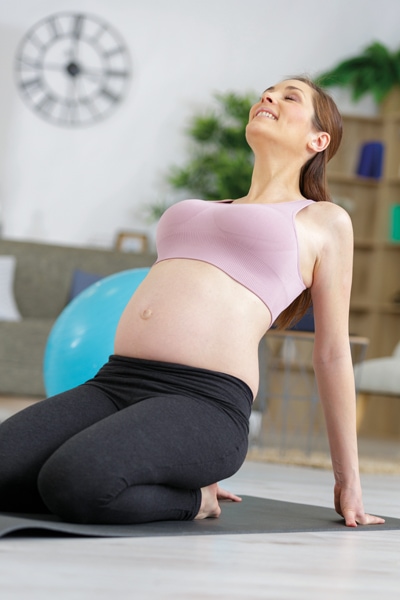
Yoga for fertility
How to adapt a yoga practice to optimise fertility. By Naomi Murphy and Sally Parkes
A yoga that enhances a woman’s fertility is about adapting the practice of yoga to her own feminine cyclic nature. It is of great benefit to women who are trying to grow their family. This is because yoga for fertility can help a woman forge a strong mind-body connection, helping her to become more aware of her body’s needs, thus helping to control stress hormones, which in turn helps to regulate the menstrual cycle – all of which is invaluable when trying to conceive.
A masculine practice by origin, many yoga classes are often energetically ‘yang’ and so stimulate the body as opposed to relaxing it. This approach of course has its place and can be very effective in progressing ones strength and fitness levels as well as clearing the mind. However, when practiced out of tune with the female cycle, it can negatively increase the stress placed upon the female body. There is now science-based data that supports this suggestion too, with a study called the Oxford Conception Study led by Cecilia Pyper, MB.BS. (published by The National Institute of Health) finding that alleviating stress as opposed to increasing it, can increase the likelihood of conception.
According to Dr. Pyper: “This is the first study to show an association between a biomarker of stress and a reduction in women’s chances of conceiving throughout the fertile window — underscoring the importance of considering stress when attempting to identify the determinants of conception.”
Therefore, a yoga practice that helps a woman to honour her natural fluidity, and one that flows with her cyclical nature via a more feminine approach, may look and feel much softer and less linear, than a more traditional method of yoga, and so will more likely help the yogini in achieving her optimum health, vitality and fertility.
For a greater understanding, we can break the cycles down into four distinct phases:
- Menstruation phase: our ‘period’.
- Follicular phase: multiple follicles are growing within the ovaries, with rising oestrogen helping one follicle to be chosen to release an egg.
- Ovulation phase: The dominant follicle releases the egg, where it will either be fertilised or disintegrate within 24 hours.
- Luteal phase: the time post-ovulation and pre-menstruation. Progesterone rises during this time and when it starts to drop, this signals time for menstruation to begin. Collectively, these cycles are a constantly flowing wheel in motion and as a woman moves through them, it is ideal for her to gently flow from one to the next, as opposed to abruptly changing her energy expenditure. In this way we can avoid depleting energy levels and directing blood flow away from the womb, where is it very much needed to transport nutrients to the uterus which in turn supports the creation of new life.
Sally Parkes and Naomi Murphy run online 30hr Fertility Yoga Teacher Training. Follow them at @sallyparkesyoga @realfertile

How to adapt a yoga practice to optimise fertility:
Menstruation
After resting for the first day or two of this phase, the level of activity can be slowly increased. This will assist in the shedding the old and beginning anew, both physically and energetically. Strength work can slowly be increased whilst still focusing on the downward flow of Apana Vayu, with strong abdominal work best avoided. Meditations that focus on celebrating womanhood, and new possibilities and beginnings are also particularly effective at this time.
Follicular phase
In this second phase, testosterone and oestrogen levels are at their peak, giving us the most energetic week of the month making it the most ideal time for a more yang energy practice. Powerful sun salutations and Ujjayi breath work well here as do inversions and yoga asana that twists the torso, with the latter ideally still practiced sparingly however. Meditations that focus on a woman’s powerful Shakti feminine energy and sexuality are also helpful during this phase.
Ovulation
Energy levels remain high in the first half of ovulation, but as the progesterone levels increase, strength will begin to decline and a slower physical pace will occur, with yang energy being replaced with yin energy. Moon salutations are ideal to practice at this point as the woman begins to take on calm moon-like qualities. Flowing movement of the hips can work wonders at this time by encouraging blood flow to the pelvic area, whilst strong abdominal work and intense twists should be avoided. Meditations that celebrate the femininity of the heart and womb are wonderful additions to the ovulation week.
Luteal phase
The fourth phase of the feminine cycle is traditionally the premenstrual phase, where symptoms such as muscle tension and tiredness can start to take effect due to a drop in progesterone levels. It can also be a time of intense emotions for a woman who is hoping to conceive as she waits to see if menstruation occurs. Therefore, focusing on de-stressing at this time is key to her wellbeing with a relaxing restorative-based yoga practice ideal as it allows the woman to enjoy asana that are reflective and grounding. Floor-based asana, yoga nidra meditations and extra-long Savasanas are perfect. Furthermore, it is helpful to consider oneself pregnant until knowing otherwise with




